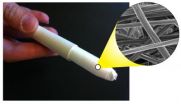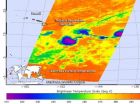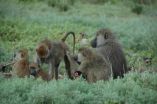(Press-News.org) Everybody knows the shortest distance between two points is a straight line, and now Harvard researchers have evidence that sperm have been taking the familiar axiom to heart.
Though competition among individual sperm is usually thought to be intense, with each racing for the chance to fertilize the egg, Harvard scientists say in some species, sperm form cooperative groups that allow them to take a straighter path to potential fertilization.
A new study, conducted by Heidi Fisher, a post-doctoral student working in the lab of Hopi Hoekstra, Howard Hughes Investigator and Professor of Organismic and Evolutionary Biology and Molecular and Cellular Biology and the Alexander Agassiz Professor of Zoology in the Museum of Comparative Zoology and post-doctoral student Luca Giomi working with L Mahadevan, the Lola England de Valpine Professor of Applied Mathematics, of Organismic and Evolutionary Biology, and of Physics shows that in Peromyscus maniculatus, a species of deer mouse known to be promiscuous sperm clump together to swim in a more linear fashion. The study is described in a July 23 paper in Proceedings of the Royal Society B.
"We generally think that each individual sperm cell swims its little heart out to get to the egg," Hoekstra said. "But it had been discovered that, in at least a handful of organisms, sperm will cooperate and swim as a group."
Exactly why sperm clump together, however, had remained a mystery – until now.
"We had some hints that cooperation was enhancing their swimming performance, but what we didn't understand was how it was helping," Fisher said. "With this study, we combined a mathematical model with much finer-scale measurements that looked at groups that ranged from single sperm cells to groups of as many as 30 cells. What we realized was that that while their overall speed wasn't increasing at all, but that the time it took them to go from point A to point B was decreasing -- they swim in a straighter line."
The study, also found that sperm from promiscuous mice were more likely to form clumps of the optimum size, and that, when compared with sperm from Peromyscus polionotus – a closely-related, but monogamous, species of mouse – the trait is likely driven by sexual selection.
The new paper builds on a 2010 study conducted in Hoekstra's lab which found that sperm cells preferentially clump with those produced by the same male. Spurred by that earlier paper, Mahadevan approached Hoekstra with the idea of creating a mathematical model to understand whether and how sperm received an advantage by forming groups.
"I read the paper and thought we could make a quantitative theory of the observations they had made," he said. "But of course, the only way to know whether any model was capable of anything predictive was to make it testable.
"In this context…the question was: Is it possible to make the aggregate do better than then individual?" he continued. "One way to do that is to get all the tails to synchronize, but that doesn't happen. The other way is to cancel out the random motion of the individuals in an aggregate because the sperm adhere to each other. Eventually, for large aggregates, the sperm point towards each other and thus cannot swim at all. This mechanism when quantified in a model that Luca and I developed and this led to testable predictions., When Heidi did the experiment, we found that this was essentially correct."
In addition to finding that sperm which group together to swim in a more linear fashion, researchers were able to identify at what clump size sperm reaped the largest reward for grouping together. Groups with too few cells, Hoekstra said, continued to swim along more meandering paths, while much larger groups often resulted with sperm swimming against each other.
"What we found is that both species have an optimum at around eight, which was what the model predicted, but there were many fewer groups that were too big or too small in the promiscuous species," she said. "That is consistent with the idea that sexual selection is driving this trait in the promiscuous species, whereas in the monogamous species, where there's not as much competitive pressure, things are a bit more relaxed, so we see more variance in the clump sizes."
In the end, Mahadevan said, the study represented an ideal collaboration between the theoretical and the empirical.
"If you talk to evolutionary biologists, their approaches are often genetic, because they're trying to understand what the genetic bases are for natural selection pressures," he said. "From a theoretical point of view, the focus is on reproductive capacity. What's interesting in this particular situation is we can take a question of reproductive capacity and add a physiological twist to it that's associated with sperm motility, and then we can take that apart in the context of what happens when you change the shape of the sperm, or their ability to adhere to each other, or their ability to move."
"In my view we haven't so much answered the question as we've sharpened it," he continued. "And we've done by that couching a conceptual notion of competition and cooperation in terms of physical and physiological variables that can be measured and lead to testable predictions."
INFORMATION:
When cooperation counts
Researchers find sperm benefit from grouping together in mice
2014-07-30
ELSE PRESS RELEASES FROM THIS DATE:
Scientists call for new strategy in pursuit of HIV-free generation
2014-07-30
In light of the recent news that HIV has been detected in the Mississippi baby previously thought to have been cured of the disease, researchers are assessing how to help those born to HIV-infected mothers. These infants around the world are in need of new immune-based protective strategies, including vaccines delivered to mothers and babies and the means to boost potentially protective maternal antibodies, say researchers who write in the Cell Press journal Trends in Microbiology on July 30th.
"There is a real need for additional HIV-1 prevention methods for infants," ...
Study: Marine pest provides advances in maritime anti-fouling and biomedicine
2014-07-30
A team of biologists, led by Clemson University associate professor Andrew S. Mount, performed cutting-edge research on a marine pest that will pave the way for novel anti-fouling paint for ships and boats and also improve bio-adhesives for medical and industrial applications.
The team's findings, published in Nature Communications, examined the last larval stage of barnacles that attaches to a wide variety of surfaces using highly versatile, natural, possibly polymeric material that acts as an underwater heavy-duty adhesive.
"In previous research, we were trying to ...
Dissolvable fabric loaded with medicine might offer faster protection against HIV
2014-07-30
Soon, protection from HIV infection could be as simple as inserting a medicated, disappearing fabric minutes before having sex.
University of Washington bioengineers have discovered a potentially faster way to deliver a topical drug that protects women from contracting HIV. Their method spins the drug into silk-like fibers that quickly dissolve when in contact with moisture, releasing higher doses of the drug than possible with other topical materials such as gels or creams.
"This could offer women a potentially more effective, discreet way to protect themselves from ...
NASA sees zombie Tropical Depression Genevieve reborn
2014-07-30
Infrared imagery from NASA's Aqua satellite helped confirm that the remnant low pressure area of former Tropical Storm Genevieve has become a Zombie storm, and has been reborn as a tropical depression on July 30.
Tropical Storm Genevieve weakened to a tropical depression on Sunday, July 27 and the National Hurricane Center issued their final advisory on the system as it was entering the Central Pacific. Now, after three days of living as a remnant low pressure area, Genevieve reorganized and was classified as a tropical depression again.
The Tropical Rainfall Measuring ...
Birthweight and breastfeeding have implications for children's health decades later
2014-07-30
Young adults who were breastfed for three months or more as babies have a significantly lower risk of chronic inflammation associated with cardiovascular and metabolic diseases, according to research from the Brown School at Washington University in St. Louis.
"This study shows that birthweight and breastfeeding both have implications for children's health decades later," said Molly W. Metzger, PhD, assistant professor at the Brown School and a co-author of the study with Thomas W. McDade, PhD, of Northwestern University.
"Specifically, we are looking at the effects ...
Appreciation for fat jokes, belief in obese stereotypes linked
2014-07-30
BOWLING GREEN, O.—From movies to television, obesity is still considered "fair game" for jokes and ridicule. A new study from researchers at Bowling Green State University took a closer look at weight-related humor to see if anti-fat attitudes played into a person's appreciation or distaste for fat humor in the media.
"Weight-Related Humor in the Media: Appreciation, Distaste and Anti-Fat Attitudes," by psychology Ph.D. candidate Jacob Burmeister and Dr. Robert Carels, professor of psychology, is featured in the June issue of Psychology of Popular Media Culture.
Carels ...
Many depressed preschoolers still suffer in later school years
2014-07-30
Children diagnosed with depression as preschoolers are likely to suffer from depression as school-age children and young adolescents, new research shows.
Depressed preschoolers were 2.5 times more likely to suffer from the condition in elementary and middle school than kids who were not depressed at very young ages, according to researchers at Washington University School of Medicine in St. Louis.
Their study is published in the July issue of the American Journal of Psychiatry.
"It's the same old bad news about depression; it is a chronic and recurrent disorder," ...
Penn researchers: Naltrexone may diminish impulse control disorders in Parkinson's disease patients
2014-07-30
(PHILADELPHIA) – Up to 20 percent of Parkinson's disease (PD) patients and their families may confront a common but largely unrecognized challenge: the occurrence of impulse control disorders (ICDs) such as compulsive gambling, sexual behavior, eating, or spending. Yet the presence of PD in these patients can severely limit or complicate treatment options. A team of investigators from the Perelman School of Medicine at the University of Pennsylvania and the Parkinson's Disease Research, Education and Clinical Center (PADRECC) at the Philadelphia Veterans Affairs Medical ...
Study: Telephone support program beneficial for caregivers of those with dementia
2014-07-30
PROVIDENCE, R.I. – Rhode Island Hospital researchers have found that a support program administered entirely by telephone can significantly reduce depression and other symptoms in informal caregivers, such as family or friends, of individuals with dementia. The study is published online in advance of print in the journal Alzheimer's & Dementia.
"Those caring for people with Alzheimer's disease or other forms of dementia are often under a great deal of pressure," said principal investigator Geoffrey Tremont, Ph.D, of the division of neuropsychology in the department of ...
Supportive moms and sisters boost female baboon's rank
2014-07-30
DURHAM, N.C. -- A study of dominance in female baboons suggests that the route to a higher rank is to maintain close ties with mom, and to have lots of supportive sisters.
A female baboon's social status is dictated not by size or strength, but by the rank of her mother -– the higher the mother is ranked, the higher-ranked her daughter will be. For this reason, dominance rank in female baboons is thought to be determined at birth. Females born to high-ranking mothers are guaranteed a good spot in the pecking order, whereas females born to low-ranking mothers are usually ...
LAST 30 PRESS RELEASES:
Managing meandering waterways in a changing world
Expert sounds alarm as mosquito-borne diseases becoming a global phenomenon in a warmer more populated world
Climate change is multiplying the threat caused by antimicrobial resistance
UK/German study - COVID-19 vaccine effectiveness and fewer common side-effects most important factors in whether adults choose to get vaccinated
New ultraviolet light air disinfection technology could help protect against healthcare infections and even the next pandemic
Major genetic meta-analysis reveals how antibiotic resistance in babies varies according to mode of birth, prematurity, and where they live
Q&A: How TikTok’s ‘black box’ algorithm and design shape user behavior
American Academy of Arts and Sciences elects three NYU faculty as 2024 fellows
A closed-loop drug-delivery system could improve chemotherapy
MIT scientists tune the entanglement structure in an array of qubits
Geologists discover rocks with the oldest evidence yet of Earth’s magnetic field
It’s easier now to treat opioid addiction with medication -- but use has changed little
Researchers publish final results of key clinical trial for gene therapy for sickle cell disease
Identifying proteins causally related to COVID-19, healthspan and lifespan
New study reveals how AI can enhance flexibility, efficiency for customer service centers
UT School of Natural Resources team receives grant to remove ‘forever chemicals’ from water
Sweet potato quality analysis is enhanced with hyperspectral imaging and AI
Use of acid reflux drugs linked to higher risk of migraine
For immigrants to Canada, risk of MS increases with proportion of life spent there
Targeted use of enfortumab vedotin for the treatment of advanced urothelial carcinoma
A university lecture, with a dash of jumping jacks
How light can vaporize water without the need for heat
These giant, prehistoric salmon had tusk-like teeth
New study infers our wellbeing by analyzing the language we use around ageing, using language markers to enable "a different type of access to individuals’ inner worlds"
New research confirms plastic production is directly linked to plastic pollution
MSU researchers uncover 'parallel universe' in tomato genetics
Grey cuckoo, red cuckoo: unveiling the genomic secrets of color polymorphism in female cuckoo birds
CHOP researchers discover underlying biology behind Fontan-associated liver disease
A flexible microdisplay can monitor brain activity in real-time during brain surgery
Diversity and productivity go branch-in-branch
[Press-News.org] When cooperation countsResearchers find sperm benefit from grouping together in mice





